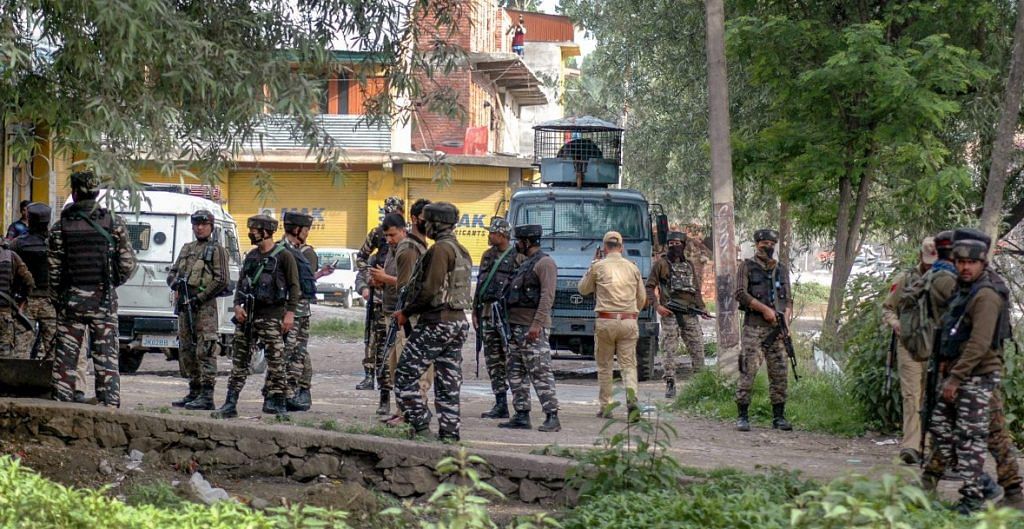New Delhi: In setting the stage for the abrogation of Jammu & Kashmir’s special status, guaranteed under Article 370, the Modi government has fulfilled a dream that predates the Bharatiya Janata Party (BJP) by decades.
Since the 1950s, it has been a pet cause of the Rashtriya Swayamsevak Sangh (RSS), the ideological fountainhead of the BJP, and its affiliates to strip J&K of its special status in order to ensure its full integration with India.
ThePrint brings you a brief history of the RSS’ campaign to abrogate Article 370, which was included in the Constitution in 1949 and has been gradually diluted in strength since then.
Patel seeks Golwalkar’s help on Kashmir
The RSS’ role in Kashmir can be traced to the early days of Indian independence, when its cadres reportedly helped Hindu refugees during the Partition.
According to Walter Andersen and Shridhar D. Damle’s book The Brotherhood in Saffron, in 1947, India’s then home minister Sardar Vallabhbhai Patel approached then RSS sarsanghchalak M.S. Golwalkar to help convince Maharaja Hari Singh of J&K to join the Indian Union.
Golwalkar met Singh in October 1947 and urged him to “recruit Punjabi Hindus and Sikhs” into his militia. Soon afterwards, as Pakistani tribals invaded Kashmir to trigger the war of 1947-48 and Indian troops arrived in the Valley, RSS volunteers were armed by the Army to fight them.
Also read: Modi’s Mission Kashmir was to make scrapping of Article 35A a necessity. That moment is now
Praja Parishad Party and the Kashmir agitation
By 1950, Article 370 had been enacted and the ban on the RSS lifted. Prem Nath Dogra, then the RSS in-charge in J&K, and another prominent Sangh leader Balraj Madhok launched the Praja Parishad Party in the state.
The aim of the Praja Parishad Party was to integrate the state into the Indian Union and deny Kashmir any form of administrative autonomy.
The next year saw the birth of the Bharatiya Jana Sangh, the predecessor of the BJP and the political arm of the RSS, under Syama Prasad Mookerjee.
In a letter to Nehru in 1952, Mookerjee talked about the “inherent right to demand that they (Kashmiris) should be governed by the same Constitution as has been made applicable to the rest of India. If the people of Kashmir Valley think otherwise, must Jammu also suffer because of such unwillingness to merge completely with India?”
The same year, the Jana Sangh held its first annual session at Kanpur.
Speaking at the meeting, Mookerjee reportedly told the delegates that they had two core agendas, “J&K’s special relationship with India” and the “state of Hindus in East Bengal”.
According to The Brotherhood in Saffron, it was at this Jana Sangh meeting that a decision was taken to launch an agitation by the end of the year, with the primary goal being the “abolition of Article 370”. Secondary goals included the integration of Kashmir into India and the separation of “Hindu Jammu” from Kashmir, setting the stage for trifurcation demands.
This agitation was headed by the Praja Parishad Party and it was supported by both the Jana Sangh and the RSS.
The stir reportedly soon spread to Punjab and Delhi. Mookerjee died in June 1953 and the agitation failed to meet its demands, but this was the first instance of mass mobilisation by the Sangh Parivar for the abolition of Article 370.
Meanwhile, the circumstances of Mookerjee’s death gave him martyr status among Sangh followers as an ardent advocate of the Kashmir cause.
In 1953, Mookerjee defied the requirement of a government permit to snuck into Kashmir, according to Andersen and Damle’s book. He was arrested in May, and died in jail a month later.
Also read: Explained: This is what Modi govt has done to scrap Article 370, 35A in Jammu & Kashmir
‘Only one way to keep Kashmir’
The stance of the RSS and its affiliates vis-a-vis Kashmir has stayed the same since then.
Deendayal Upadhyay, the then organisational secretary of the Jana Sangh, wrote in 1960, “Bharatiya Jana Sangh has… at its Nagpur Session demanded that Article 370 of the Constitution which was of a temporary nature should be repealed. So long as this Article continues, normalcy in Kashmir in the matter of constitutional arrangements vis-a-vis Bharat will not be restored.”
Seven years later, in 1967, Golwalkar reiterated the opinion in an interview to Organiser, the RSS mouthpiece.
“There is only one way to keep Kashmir — and that is by complete integration. Article 370 must go; the separate flag and the separate constitution must go too,” said Golwalkar.
“If the border area of North-East Frontier Agency (NEFA) can be centrally administered through the Army, why the border area of Kashmir can’t be administered similarly for the same strategic reasons?” he added.
Also read: On Article 370, India hasn’t violated any international treaty. That’s why world won’t react
